________________
PROBLEM OF AVIDYA
[CH.
because of this that sometimes they speak in parables. Speaking of the reason why one sees the world and not the self the Katha Upanisad says: 'Svayambhu (the self-subsistent principle who has all the conditions of self-existence in himself) cut open the out-seeing organs and so one sees outward (paran) and not the self inside (antarätman). A wise man, however, desirous of immortality sees the inside self with his eye turned away from the external world. The stupid, however, follow the external desires. They enter the outspread trap of death. The wise, however, seeing immortality, the eternal among the noneternal, do not desire (for any thing) in this world." Perception of the external and attachment to the world are the legacy handed down by Svayambhu and none is responsible for that. But the legacy is not a perpetuity. Nor is it an ultimate truth. One is only to turn away and turn back to get rid of that legacy. This is the teaching of the Upanisads. The face of truth is covered by a golden vessel." We live in truth and yet are ignorant of it. We tread upon truth and yet do not recognize it. The Chandogya says: 'Even as those who are ignorant of the secret contents of the earth do not have access to the hidden store of gold even though they tread upon the surface of it, exactly so all these common people carried away by untruth (anṛtena pratyūḍhāḥ), even though they daily go there, do not have access to the Brahmaloka (region of the Brahman or truth).'" Truth is very near us. We ourselves are truth. One does not know it because one does not care to lift the veil covering it. 'The stupid, falsely considernig themselves wise and learned, reside within the fold of avidya, and meet misfortunes running to and fro.'4 Avidya is a knot to be cut asunder, and it is not beyond our power to do so. oneness of the world with the self dispels all darkness. come from Purușa, the Absolute, and so is identical with It. It has no existence of its own, and as such cannot persist for one who has realized the Absolute, or rather become the Absolute. The Mundaka Upanisad says: 'The Puruşa is all this-karman (sacrifice), tapas (austerity) and Brahman, the highest immortal. He who knows this as hidden in the cave cuts asunder, O darling, the knot of avidya even (while living) here (in this world).'5
Realization of The world has
114
parāñci khăni vyatṛṇat svayambhus tasmät paran paśyati nantarätman. kaścid dhiraḥ pratyagātmānam aikṣad āvṛtta-cakṣur amṛtatvam icchan. parācaḥ käman anuyanti bālās te mṛtyor yanti vitatasya pāśam atha dhira amṛtatvam viditvä dhruvam adhruveşv iha na prarthayante.
-KUP, II. 4. J-2.
2 hiranmayena patrena satyasya 'pihitam mukham.-IUP, 15.
3 ChUp, VIII. 3. 2.
4 KUP, I. 2. 5.
Jain Education International
For Private & Personal Use Only
5 MuUp, II. I. TO.
www.jainelibrary.org




